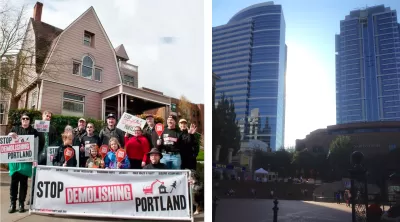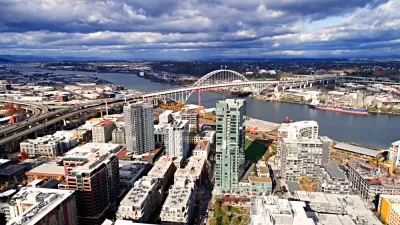Oregon's poster child for livable planning is embroiled in new controversies over destructive growth, skyrocketing prices, and back-room cronyism.

A few weeks ago, Portland residents got some unsurprising news: the city's housing prices are officially rising faster than anywhere else in the nation. Data released from the S&P Dow Jones Indices put Portland on top at an 11.8 percent increase, year over year.
For several years already, the Portland real estate market has been increasing supply to meet the growing demand, with a surge of construction in new homes and, especially, apartments. In the past year, over 20,000 new units have been built, and the feverish pace of building is accelerating. "Clearly the supply is on the way to ameliorate this issue," local housing economist Jerry Johnson told the BikePortland newsletter. "Eventually the market always overbuilds itself."
Instead, the raging debate is about where the new units are being built—and what impact they are having on the city's storied livable heritage. Increasing numbers of residents are clearly upset at a wave of historic property demolitions, making way for ungainly '50s-style white boxes and uber-trendy, in-your-face "space invaders"—or outsized, alien-looking new buildings. Human-scale places are being crowded out by new tall buildings, and luxury condos like the new Park West tower are casting unwelcome shadows over Pioneer Square and other civic spaces.
We've been here before. Back in the 1960s, the city's design and development professions began to transform the city core by demolishing beautiful historic properties and replacing them with a mostly forgettable generation of trendy "designer Modernism"—object-buildings surrounded by parking lots and freeways, leading out to sprawling new bedroom suburbs. Then, as now, Modernism was not just a style of building, but a way of thinking of cities as industrial creations, given an appropriate marketing dazzle by artist-architects. In Portland, the results of this "modernization" were almost universally dismal, as they were in so many other cities. Starting in the late 1960s, activist citizens generated a wave of human-scale reform, and out of that legendary era came Portland's vaunted urban renaissance: Pioneer Square, Skidmore, Tom McCall Waterfront Park, light rail, streetcars, and countless other innovations.
Importantly, the new renaissance built on its own local heritage and natural livability, and not on the latest international designer novelties. That localist ideal set up Portland to become a more distinctive, more durable, more sustainable competitor, and the resulting appeal played no small role in fueling Portland's economic success.
Today the emphasis is still on mixed use and streetcars, but thanks to global architectural fashions, the anywhere-Modernism has come back—artsy (some would say cynical) designer packaging for a free-wheeling style of outscale real estate development. In the city's new Central City 2035 plan, it's easy to find generous deregulations for developers, but difficult to find any meaningful heritage protection.
Certainly, too, few of the city's architectural and planning elites seem to take seriously the idea that the best way to have an urban renaissance is in fact to have a re-naissance: a re-birth: that is, to build on history and nature, as renaissances always have, including Portland's own. Indeed, there is surprisingly little critical assessment of the new/old Modernist orthodoxy, namely, the sneering prohibition of the successes of history in favor of the experimental novelties of industrial art. For the city's architectural and planning leadership, it seems, learning from the successes (and the mistakes) of the past is no longer fashionable.
Nowhere is this cultural amnesia more apparent than in the city core, where planning officials seem determined to create a pale imitation of Vancouver, British Columbia. That Canadian city has done an admirable job of partially mitigating the wave of global capital that washed over its shores, fueling a tall-building boom. But Vancouver has also seen many problems and controversies, and confronted lessons that Portland would do well to study more carefully.
Moreover, Vancouver has several crucial (if too easily overlooked) differences from Portland. Its large blocks allow point towers (slender towers in the middle of the block) with minimized impact on the streets, whereas Portland's small blocks result in massive volumes at the street and dark, dead spaces (like Burnside below US Bancorp Tower, one of the most notably dead Modernist places in the city).
Why is the city government so intent on the tall-building model? After all, the contribution to regional density of marginally more, and marginally taller, buildings in the city's small core will be modest at best – less than 1 percent of the region's population in the next 20 years, by some counts. There are far more units to be gained regionwide outside the core—especially in the empty parking lots and declining commercial zones of the periphery, where density is lowest. A polycentric model could offer existing residents the amenities of new walkable mixed-use nodes, while keeping their preferred homes and ways of life relatively unaffected.
Instead, the city is piling on within already relatively dense core districts, where the market offers low-hanging fruit—and the most potential to do damage, without careful controls. But such controls are in scarce supply. Instead city planners seem to have developed an "irrational exuberance" for the symbolism of tall buildings, combined with some oddly magical thinking about the miraculous trickle-down powers of tall buildings.
Some of that magical thinking lays at the feet of neo-liberal economist Ed Glaeser, who has famously challenged Jane Jacobs' model of urban diversity in strategically curated populations, incomes, and—crucially in this case—building ages and conditions. For Glaeser, by contrast, the simplistic answer to a housing shortage is increased supply, delivered in the form of tall buildings in the city center. Following Glaeser's model, what Portland ought to do is to double down, and build much taller buildings right in the core. That will bring down prices.
Nonsense, says Peter Elmlund, an economist at Stockholm's Ax:son Johnson Foundation. Elmlund rebuts Glaeser on several grounds. One, real estate is not an inter-changeable commodity independent of geography; in fact, the "commodity" is not the housing unit at all, but the place—the location in relation to the network of other places around it. Sometimes, adding certain kinds of housing units (such as high-end ones) can improve the value and desirability of such a place, and actually raise surrounding prices, rather than lower them.
Second, the price of housing units will never fall below the marginal cost of producing them—or else, of course, they would not be produced at all. But tall buildings are much more expensive to build for a number of reasons, including stiffening against wind and earthquakes, greater space required for elevators and stairs, expensive finishes, exterior maintenance costs, and so on. That's why they are overwhelmingly occupied by the wealthy, with perhaps a few set-asides for a small percentage of affordable housing, public space, or tokenistic historic preservation projects.
It is this "supply side" model that seems to be most appealing to Portland planners. (Ironically so, given the City's politically progressive identity.) At a recent meeting with central city neighborhood residents, chief planner Joe Zehnder proudly revealed how he plans to use Floor Area Ratio bonus credits to pile up tall buildings at corner locations, so as to spare small historic structures, and perhaps create additional open plaza spaces. But that assumes, of course, that developers will find the credits more valuable than simply razing the historic structure and building a tall building (if not quite so tall) anyway. It also assumes that a shiny new tall building looming over a windswept plaza or overshadowed historic property—with the usual perishable anywhere-Modernist design—is actually a positive model of urban development.
This supply-side approach also fails to recognize that the credits for affordable housing, historic preservation, and public space dedications, are little more than Band-Aids on top of a runaway process fueled by the very buildings that the city is now deregulating. It is a tokenistic approach, focusing on small gains at the expense of a much broader loss that it self-generates.
It is here that the city's planning leadership is failing most. It is failing to understand—just as Glaeser has failed to understand—Jacobs' argument for a more dynamic, more distributed, morediverseapproach to urban development. It is failing to spread the growth into a more distributed, catalytically targeted, polycentric regional system. Instead, the city is practicing "hypertrophy-in-place"—hoping that silver bullets, or magical towers, will deliver some kind of great boon to the city.
But this is a faith that has little support in the form of evidence. On the contrary, the evidence is that Portland will join the host of other eviscerated cities whose leadership caused such catastrophic damage to their own urban treasures.
Naturally, developers and architects are not too eager to educate the city on its errors. On the contrary, a groupthink culture styles itself as the vanguard of sustainability and progress, while it does an admirable job of tending to its own business interests.
Well, businesses will tend to do that. As Upton Sinclair famously said, "it is difficult to get a man to understand something, when his salary depends on his not understanding it." But of course it's the job of city governments to tend a larger commons, and to learn and to apply the lessons needed, and not to be swayed by insider groupthink.
Unfortunately the evidence is growing that the city has not only learned its own lessons, it has packed its boards and panels with insiders whose apparent (and apparently rampant) conflicts of interest remained undisclosed. Late last year, the city ombudsman issued a finding that the City's Stakeholder Advisory Committee (SAC) for the west quadrant failed to follow required ethical procedures, and many participants who had apparent conflicts of interest should have disclosed them. An investigative report in the local Northwest Examiner newspaper showed that almost three-fourths of the SAC consisted of developers and related professionals, while almost none were actual residents.
Zehnder and others argue that they are trying to do good things for the city, by making it easier for private interests to do good projects. I believe they are sincere. But developers are more responsive to certainty and predictability in the process than they are to deregulation in the abstract. Right now the biggest problems with incentivizing good development in the city is not allowable height, but rather, a hopelessly bureaucratic and subjective entitlement process—one that has onerous controls on all thewrongthings.
Instead of clear, predictable form-based codes that guide development to blend sensitively with the scale of its neighbors and to mitigate its impacts, the city imposes a subjective game of "impress the design panelists" and "who's the best renderer"—for drawings that are famously unlike the built result. (The much-discussed Burnside Bridgehead project—nicknamed "Darth Vader" for its in-your-face Modernism—is a troubling case in point.)
This onerous process certainly adds cost, but it arguablysubtractsquality. Thankfully, several of the new mayoral candidates have articulated this problem, and a change may be in the air. Meanwhile, the city staff plods on, making marginal and tokenistic concessions to growing criticism. (There are signs the city is trying to dismantle or at least marginalize the vaunted neighborhood involvement system, the one that helped fuel the city's urban renaissance. But that stiff-arming effort is also getting called out by several of the new mayoral candidates.)
Over a half century ago, Jane Jacobs made a series of lucid, compelling arguments for tackling gentrification, loss of diversity, urban decline, and related ills. She argued against "silver bullets"—of which "silver towers" are one sad example—and for a networked, diversified approach. Her criticism of planners' faith in centralized, supply-side approaches was withering, and she took no prisoners.
In the half-century since, the evidence for the correctness of her approach is accumulating. So too is the evidence of what happens when—as in the sad case of Portland—planners and architects choose to ignore those important history lessons.
Michael Mehaffy is Executive Director of Portland-based Sustasis Foundation, and he works internationally on urban development issues.

Maui's Vacation Rental Debate Turns Ugly
Verbal attacks, misinformation campaigns and fistfights plague a high-stakes debate to convert thousands of vacation rentals into long-term housing.

Planetizen Federal Action Tracker
A weekly monitor of how Trump’s orders and actions are impacting planners and planning in America.

In Urban Planning, AI Prompting Could be the New Design Thinking
Creativity has long been key to great urban design. What if we see AI as our new creative partner?

Portland Raises Parking Fees to Pay for Street Maintenance
The city is struggling to bridge a massive budget gap at the Bureau of Transportation, which largely depleted its reserves during the Civd-19 pandemic.

Spokane Mayor Introduces Housing Reforms Package
Mayor Lisa Brown’s proposals include deferring or waiving some development fees to encourage more affordable housing development.

Houston Mayor Kills Another Bike Lane
The mayor rejected a proposed bike lane in the Montrose district in keeping with his pledge to maintain car lanes.
Urban Design for Planners 1: Software Tools
This six-course series explores essential urban design concepts using open source software and equips planners with the tools they need to participate fully in the urban design process.
Planning for Universal Design
Learn the tools for implementing Universal Design in planning regulations.
Gallatin County Department of Planning & Community Development
Heyer Gruel & Associates PA
JM Goldson LLC
City of Camden Redevelopment Agency
City of Astoria
Transportation Research & Education Center (TREC) at Portland State University
Jefferson Parish Government
Camden Redevelopment Agency
City of Claremont




























